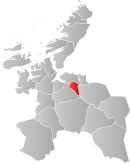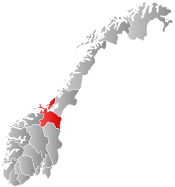Klæbu
| Klæbu kommune | |||
|---|---|---|---|
| Municipality | |||
 | |||
| |||
 Klæbu within Sør-Trøndelag | |||
| Coordinates: 63°16′34″N 10°30′51″E / 63.27611°N 10.51417°ECoordinates: 63°16′34″N 10°30′51″E / 63.27611°N 10.51417°E | |||
| Country | Norway | ||
| County | Sør-Trøndelag | ||
| District | Trondheim Region | ||
| Administrative centre | Klæbu | ||
| Government | |||
| • Mayor (2007) | Jarle Martin Gundersen (Sp) | ||
| Area | |||
| • Total | 186.36 km2 (71.95 sq mi) | ||
| • Land | 175.06 km2 (67.59 sq mi) | ||
| • Water | 11.30 km2 (4.36 sq mi) | ||
| Area rank | 337 in Norway | ||
| Population (2010) | |||
| • Total | 5,801 | ||
| • Rank | 185 in Norway | ||
| • Density | 33.1/km2 (86/sq mi) | ||
| • Change (10 years) | 19.0 % | ||
| Demonym(s) | Klæbygg[1] | ||
| Time zone | CET (UTC+1) | ||
| • Summer (DST) | CEST (UTC+2) | ||
| ISO 3166 code | NO-1662 | ||
| Official language form | Bokmål | ||
| Website |
www | ||
|
| |||
Klæbu is a village and municipality in Sør-Trøndelag county, Norway. It is located in the southern part of the Trondheim Region, about 20 kilometres (12 mi) south of the city of Trondheim. The administrative center is the village of Klæbu. The other major village in Klæbu is Tanem.
The village of Klæbu is located along the Nidelva river. The 1.57-square-kilometre (390-acre) village has a population (2013) of 3,187. The population density is 2,030 inhabitants per square kilometre (5,300/sq mi).[2]
Even though agriculture has traditionally been the main industry for Klæbu, the municipality now functions more as a commuter town of Trondheim, where many of Klæbu's inhabitants work or attend school.
It is scheduled to merge with the municipality Trondheim January 1st 2020.[3]
General information
The municipality of Klæbu was established on 1 January 1838 (see formannskapsdistrikt). On 1 January 1899, the small northwestern part of Klæbu (population: 533) was separated from Klæbu to form the new municipality of Tiller.[4]
Name
The Norse form of the name was Kleppabú. The first element is the plural genitive case of kleppr 'rocky hill' - the last element is bú 'rural district'. The district/parish has a lot of small rocky hills.[5]
Coat-of-arms
The coat-of-arms is from modern times; they were granted on 8 July 1983. The silver and blue arms symbolize the Trangfossen waterfall in the Nidelva river. The river has been of great importance for the local development, for agriculture and hydroelectricity generation, hence the use of the waterfall as a typical symbol for the municipality. The waterfall is no longer visible as that part of the river became part of Bjørsjøen lake after the building of the dam at Hyttfossen.[6]
Churches
The Church of Norway has one parish (sokn) within the municipality of Klæbu. It is part of the Deanery (prosti) of Heimdal and the Diocese of Nidaros.
| Parish (Sokn) | Church Name | Year Built | Location of the Church |
|---|---|---|---|
| Klæbu | Klæbu Church | 1790 | Klæbu |
| Vassfjell Chapel | 1974 | Vassfjellet mountain |
Geography
The Nidelva river, which runs through Klæbu, is a large source of hydroelectric power with a total of 3 power stations within the municipality borders. The river runs north from the lake Selbusjøen. The mountain Vassfjellet is located along the western border with Melhus.
The landlocked municipality of Klæbu has three municipalities that border it: Melhus is located to the west and south, Selbu is located to the east, and Trondheim is to the north.
References
- ↑ "Navn på steder og personer: Innbyggjarnamn" (in Norwegian). Språkrådet. Retrieved 2015-12-01.
- ↑ Statistisk sentralbyrå (1 January 2013). "Urban settlements. Population and area, by municipality.".
- ↑ Trondheim Kommune (17 June 2016). "Ja til sammenslåing av Klæbu og Trondheim".
- ↑ Jukvam, Dag (1999). "Historisk oversikt over endringer i kommune- og fylkesinndelingen" (PDF) (in Norwegian). Statistisk sentralbyrå.
- ↑ Rygh, Oluf (1901). Norske gaardnavne: Søndre Trondhjems amt (in Norwegian) (14 ed.). Kristiania, Norge: W. C. Fabritius & sønners bogtrikkeri. p. 364.
- ↑ Norske Kommunevåpen (1990). "Nye kommunevåbener i Norden". Retrieved 26 October 2008.
External links
| Wikimedia Commons has media related to Klæbu. |
 Sør-Trøndelag travel guide from Wikivoyage
Sør-Trøndelag travel guide from Wikivoyage- Municipal fact sheet from Statistics Norway
- Klæbu church (Norwegian)

